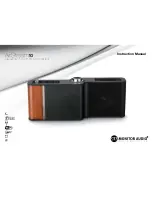
Reference
RLX-FHE, RLX-FHES, RLX-FHS
♦
RadioLinx FH
Frequency-Hopping Industrial Radio
ProSoft Technology, Inc.
Page 127 of 151
November 25, 2008
Signal Strength (RSSI):
The current signal strength (Received Signal
Strength Indicator) in dBm.
Parent Address
: The radio address of the parent radio for this network. For
repeaters or remotes, the value could be in the range of the set of addresses
composed of the parent and any repeaters, plus the roam setting of 65535.
Encryption:
The selected encryption level for the network (128 bit or
disabled)
Get Data:
To view the hardware settings for a radio, click Get Data.
Done:
Click Done to dismiss this dialog box.
15.1.29
Serial Settings Dialog Box
The Serial Settings Dialog Box opens when you click the Serial Settings button
on the Radio Configuration dialog box (page 109). Use this dialog box to
configure the way serial data packets are encapsulated and transmitted over an
Ethernet network.
Encapsulation Protocol:
Choose the encapsulation protocol from the
dropdown list.
Remote IP:
Enter the IP Address of the radio that should receive
encapsulated serial protocol packets.
Remote Port:
Select the UDP port number to use for encapsulated serial
data transmission.
Listen IP:
Enter the IP Address of the radio that should originate
encapsulated serial protocol packets.
Listen Port:
Select the UDP port number to use for encapsulated serial data
transmission.
Data Port Mode:
Select the data port mode (RS232, RS485 half-duplex or
RS485 full-duplex) from the dropdown list. The port mode on the radio must
match the port mode on the connected serial device.
Baud Rate:
Select the baud rate from the dropdown list. The baud rate on
the radio must match the baud rate on the connected serial device.
Parity:
Select the parity (None, Even or Odd) from the dropdown list. The
parity on the radio must match the parity on the connected serial device.
Data Bits:
Select the number of data bits (7 or 8) from the dropdown list. The
data bits on the radio must match the data bits on the connected serial
device.
Stop Bits:
Select the number of stop bits (1 or 2) from the dropdown list. The
stop bits on the radio must match the stop bits on the connected serial
device.
Handshaking:
Select the handshaking mode (None or Hardware) from the
dropdown list. The handshaking mode on the radio must match the
handshaking mode on the connected serial device. The radio uses RTS/CTS
for hardware handshaking.
Timeout (chars):
This value configures the length of time to look for gaps in
the data being received from the local attached device. The timer is activated
after the Minimum Packet Size has been accumulated in the radio, after
which, if the radio detects a gap in the data exceeding the Character Timeout
value, the radio will transmit the data. The radio will accumulate data in its
buffers until either
















































